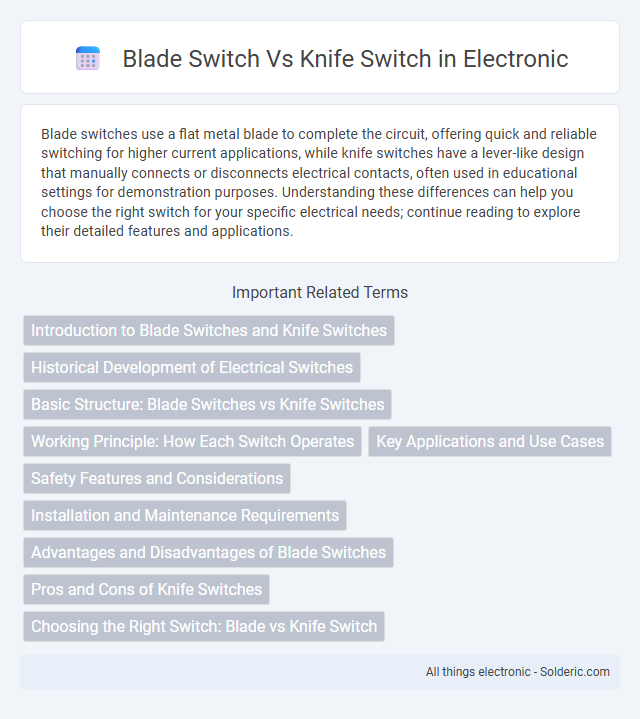Blade switches use a flat metal blade to complete the circuit, offering quick and reliable switching for higher current applications, while knife switches have a lever-like design that manually connects or disconnects electrical contacts, often used in educational settings for demonstration purposes. Understanding these differences can help you choose the right switch for your specific electrical needs; continue reading to explore their detailed features and applications.
Comparison Table
| Feature | Blade Switch | Knife Switch |
|---|---|---|
| Design | Flat, narrow metal blades | Thick metal knives or levers |
| Operation | Quick toggle action | Manual lifting and placing |
| Usage | Low to medium voltage circuits | High current and high voltage circuits |
| Safety | Enclosed designs available | Exposure risk; usually open |
| Durability | Moderate, suited for frequent switching | Robust, less frequent switching |
| Common Application | Household and small industrial use | Heavy industrial and main power circuits |
| Cost | Generally lower | Usually higher |
Introduction to Blade Switches and Knife Switches
Blade switches use a flat, spring-loaded metal blade that moves between contacts to open or close a circuit, providing reliable and quick manual control of electrical power. Knife switches consist of a hinged metal lever that pivots into a slot or jaw to establish or break the circuit, offering visible break and simple design ideal for educational and low-voltage applications. Understanding these key differences helps you select the correct switch type for your electrical control needs.
Historical Development of Electrical Switches
Blade switches emerged in the early 20th century, offering improved safety and durability over the older knife switch designs that date back to the late 19th century. Knife switches featured exposed metal contacts that posed risks of electrical arcs and accidents, whereas blade switches incorporated insulated components to enhance user safety. Your understanding of switch evolution highlights how blade switches became preferred for industrial and residential electrical systems due to their reliability and safer operation.
Basic Structure: Blade Switches vs Knife Switches
Blade switches feature a flat, spring-loaded metal blade that pivots to make or break a circuit, providing smooth and quick operation. Knife switches consist of a hinged metal lever (the "knife") that fits into a slot or jaw, offering a simple, visible open or closed position but requiring more manual effort. Both types prioritize durability, but blade switches commonly allow faster switching and safer contact engagement compared to the straightforward but bulkier knife switch design.
Working Principle: How Each Switch Operates
Blade switches operate by sliding a metal blade between contacts to open or close an electrical circuit, ensuring a reliable connection through direct contact. Knife switches function by pivoting a hinged metal lever (the "knife") into a slot or jaw on the opposite contact, allowing manual control of the circuit flow. Your choice between these switches depends on the desired ease of operation and the specific application's voltage and current requirements.
Key Applications and Use Cases
Blade switches are ideal for high-current, heavy-duty industrial applications such as motor control and power distribution due to their robust design and quick operation. Knife switches find use in educational settings, experimental circuits, and simple open/close electrical setups where visibility and ease of manual operation are priorities. Your choice between these switches depends on the specific safety requirements, current capacity, and frequency of switching needed in your application.
Safety Features and Considerations
Blade switches offer safer operation with insulated handles and enclosed contacts that minimize accidental contact and electrical arcing risks. Knife switches have exposed metal components, increasing the potential for electrical shock and arc flash hazards if not handled with proper care. Your choice should prioritize blade switches for enhanced safety in environments where operator protection is critical.
Installation and Maintenance Requirements
Blade switches feature simpler installation with straightforward mounting and minimal wiring, making them ideal for quick setup. Knife switches require precise alignment and more robust terminal connections during installation, which can increase complexity and time. Your choice impacts maintenance needs, as blade switches generally need less frequent servicing while knife switches may require regular inspections to ensure mechanical integrity.
Advantages and Disadvantages of Blade Switches
Blade switches offer rapid operation and high visibility of contact status, making them suitable for circuit isolation in industrial applications. Their primary advantage lies in simplicity and reliability under low to moderate current loads, but they are limited by exposure to environmental factors like dust and moisture, which can affect performance. Safety concerns due to exposed contacts and limited use in high voltage scenarios serve as notable disadvantages compared to enclosed switch types.
Pros and Cons of Knife Switches
Knife switches offer a straightforward design that allows for easy visual confirmation of the open or closed circuit, making maintenance and troubleshooting more intuitive. However, their exposed contacts pose safety risks such as accidental electric shocks and arcing, limiting their use in modern enclosed electrical systems. You should consider these trade-offs when choosing between blade and knife switches for your application.
Choosing the Right Switch: Blade vs Knife Switch
Choosing the right switch between a blade switch and a knife switch depends on the application's voltage, current capacity, and safety requirements. Blade switches offer quicker operation and better arc control, making them suitable for low to medium voltage circuits, while knife switches provide robust mechanical strength ideal for high current, industrial settings. Evaluating the electrical load and environmental conditions ensures optimal performance and longevity of the selected switch type.
blade switch vs knife switch Infographic

 solderic.com
solderic.com